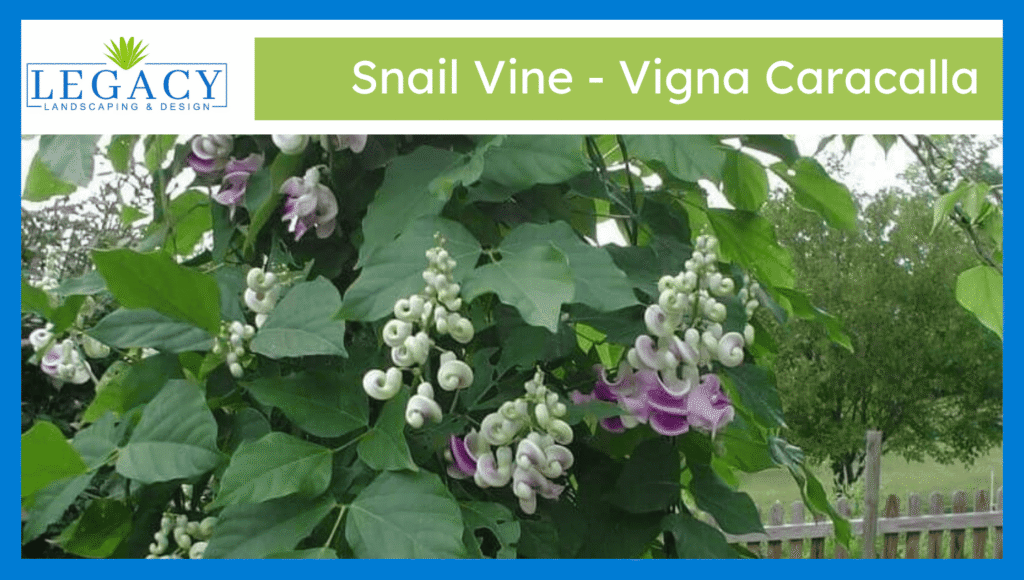Snail Vine (Vigna caracalla) is a quickly growing vine found in tropical regions of Central and South America. The plant is famous for having flowers that look like the shells of snails. These flowers are strongly fragrant and come in colours such as lavender, white and pink. According to the Missouri Botanical Garden reports that the vine is typically 15–20 feet long where temperatures are warm. It grows best when planted in full light, deep soil that drains well and an atmosphere with higher humidity. Bees and butterflies are drawn to the Snail Vine, which is often grown on trellises, fences and arbours. Where conditions are colder, gardeners plant seeds as annuals indoors or protect them through winter.
| Characteristic | Description |
| Scientific Name | Vigna caracalla |
| Common Name | Snail Vine, Corkscrew Vine |
| Size | Fast-growing vine that reaches 15–20 feet in one season under warm conditions. |
| Appearance | Twining vine with lush green foliage and spiraled, lavender-colored flowers resembling snail shells. |
| Spines | No spines present. |
| Flowers | Lavender, fragrant, corkscrew-shaped flowers bloom from mid-summer to fall; attract bees and butterflies. |
| Fruits | Produces pods after flowering; seeds can be collected for propagation. |
| Root System | Fibrous root system suited for well-drained soil; supports vigorous growth. |
| Lifespan | Perennial in warm climates; annual in cooler climates unless overwintered indoors. |
| Habitat | Native to tropical South and Central America; thrives in warm, sunny environments. |
| Water Storage | Does not store water; requires consistent moisture but not soggy soil. |
| Growth Rate | Very fast-growing in warm, sunny, and moist conditions with support like a trellis. |
| Flowering Time | Mid-summer through fall in warm climates. |
| Reproduction | Reproduces by seeds; soak seeds before planting for better germination. Grows well indoors and outdoors. |
| Pruning | Prune in early spring and lightly in summer; cut above nodes to promote branching and blooming. |
| Pet Safety | Non-toxic to cats and dogs, according to ASPCA, but best kept out of reach to prevent irritation. |
Table of Contents
How Fast Does Snail Vine Grow?
The Snail Vine can grow to 15–20 feet tall in warm weather during just one growing season. It needs to grow in an area with plenty of sun, watered soil and strong support. Cool areas cause growth to slow down, but with good water and light, it can remain strong and healthy.
Can Snail Vines Grow in Pots and Survive Winter?
Yes, if you grow Snail Vines in pots and move them indoors for the winter, they can survive. Keep the pot in bright areas but out of direct sunlight, and only water once in a while while the plant is resting. Protect your plants from cold air temperatures. After the weather is above 50°F for a few days, place your plant outdoors for it to continue growing.
How Do You Grow Snail Vine From Seed?
Soak the seeds in warm water overnight to improve germination. Plant the seeds so that only 1 inch of them is underground in damp, well-drained soil, while the temperature is between 70–85°F. Germination takes between 10 and 20 days. Move the seedlings to a pot once they have 2 to 3 real leaves. Give vine plants direct sunlight, a trellis or support and proper watering. If your area is not very warm, plant seeds inside about 4–6 weeks before the last spring frost. Make sure seedlings are ready for the weather before planting. Plant your garden in soil that is full of nutrients. Make sure the soil remains consistently moist, avoiding both overly wet and dry conditions. Proper conditions can allow flowers to form within three months. Make sure young plants are safe from cold or wind during their early stage of development.
How Do You Prune or Train Snail Vine?
You can encourage snail vines to grow in a specific direction by planting them around a trellis to force them in that direction. After the early spring season, cut down weak or dead branches. Cut down the hard stems to prevent further growth. When you are cutting, always do it above a node to promote branching. Prune lightly in the summer to help flowers bloom. Cut off faded blooms to keep your flowers blooming for longer. Try not to prune consistently when the plant is blooming. Choose clean and sharp tools to help prevent damage to the material. Keep pruning to keep your tree healthy and clean. Regular care keeps the plant easy to manage and attractive all through the growing period.
Is Snail Vine Poisonous to Pets?
No, according to the ASPCA, Snail Vine is not toxic for cats or dogs. While many consider it non-toxic, it’s better to keep it away from their reach, as chewing this may not feel good for some pets’ sensitive stomachs.
When Does Snail Vine Bloom?
Snail Vine flowers from the middle of the summer season until fall. The best conditions for flowers are warm weather, enough sunlight and moist ground. Lavender flowers with a fragrant spiral shape make bees and butterflies visit them all summer.
About The Author
Isaiah Espinoza
Isaiah Espinoza is the proud company owner, founder and driving force behind Legacy Landscaping and Design. Isaiah established Legacy Landscaping & Design in 2014, bringing his vision of creating stunning outdoor spaces to life. Isaiah, the founder of Legacy Landscaping & Design, has a deep-rooted passion for construction and design, stemming from four generations of family expertise in the industry. With a KB-1 General Building License and a CR-21 Hardscaping and Irrigation License, Isaiah has spent the past decade transforming outdoor spaces with exceptional craftsmanship and innovative design.

